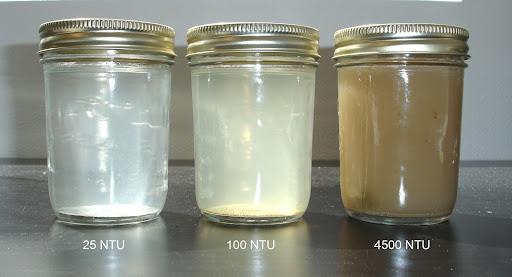
CSGP: Sampling
Sampling is a critical component in ensuring compliance with the permit. The goal of sampling is to demonstrate that your BMPS are effective, and that downstream water quality is protected.
Identifying discharge points, and using proper sampling methods are important steps to ensure your site maintains compliance with the permit requirements.
Knowing What to Sample
It is important that you have identified all of the proper sampling parameters based on the conditions and operations found at your site. All CSGP sites are required to do a weekly sampling of if discharging. If a project conducts over the life of the project pH monitoring must be conducted at the discharge point(s) and in the water storage BMPs (tanks, ponds, trap known as “impoundments”) before discharging off the site. Sites that discharge to impaired waters may have additional sampling requirements. Your project’s specific sampling requirements will be outlined within the WQPermitPortal where you submit , and it is important to periodically check that sampling requirements have not changed.

Turbidity Sampling
The instrument used to sample for turbidity depends on the size of the site. Sites greater than 5 acres in size are required to sample using a calibrated turbidimeter. Sites between 1-5 acres have the option of using a turbidimeter, or a transparency tube as a proxy for turbidity. Turbidimeters report turbidity in units of nephelometric turbidity units-NTUs, whereas the transparency tube has results reported in centimeters.

Benchmarks for CSGP Sites
| Low Benchmark | High Benchmark | |
| Turbidity | 25 NTU or 33 cm (values above these numbers indicate you need to employ more BMPs) | 250 NTU or 6 cm (indicates a high probability water quality is threatened and you need to contact Ecology within 24 hrs) – See ERTS |
| pH | 6.5 (below this number is a water quality violation and reportable) | 8.5 (above this number is a water quality violation and reportable) |

Note: projects discharging to impaired waters may encounter more stringent effluent limits- see the Impaired Waters Sampling section below.
Turbidimeter Sampling Procedures
Sampling using a turbidimeter should be performed in the field using a portable turbidimeter. Below is the general procedure for sampling turbidity using a field turbidimeter, always refer to the manufacturer’s guidelines for specific procedures.
Transparency Tube Sampling Procedures
Sampling using a transparency tube is performed in the field using a clear tube with a ruler measuring in centimeters running down the side, a black and white disk on the bottom of the instrument, and a valve near the bottom. Below is the general procedure for sampling using a transparency tube.
pH Sampling
Permitted projects conducting significant concrete work (using or storing pH-altering materials such as Portland cement-treated base, cement kiln dust, or fly ash) in an area that discharges stormwater into waters of the state-must sample their pH weekly. Significant concrete work is defined as greater than 1000 cubic yards used over the life of a project.
Projects are required to begin pH sampling after concrete installation or has occurred and must continue until these materials are fully stabilized. pH sampling can be performed with a calibrated pH pen instrument or a wide-range pH indicator paper.
Impaired Waters Sampling
Projects that discharge water into an impaired waterbody may require additional, or more stringent sampling. Impaired waters are waters determined by Ecology’s water quality assessment to be polluted with one or more contaminants and in need of water quality improvement. These waters are often referred to as 303(d) listed waters as the procedure for determining impaired waters is found under section 303(d) of the Clean Water Act.
Projects that discharge into sections of water impaired for turbidity, fine sediment, or phosphorus are subject to more stringent turbidity sampling. These sites must sample using a turbidimeter only and are subject to effluent limits as opposed to benchmarks. Exceedance of an effluent limit results in a permit violation, opening a site up to fines and lawsuits, as opposed to a benchmark that offers corrective action opportunities.

Additional Requirements for Impaired Waters
Projects discharging to impaired water must complete one of the following to be eligible for coverage under the CSGP:
- Prevent exposing stormwater to pollutants for which the waterbody is impaired, or
- Document that the pollutants for which the waterbody is impaired are not present, or
- Provide data to Ecology showing that discharge is not expected to contribute to an exceedance of a waterbody standard.
Projects that discharge to waters impaired for high pH must sample using a calibrated pH meter only and are similarly facing effluent limits for pH as opposed to benchmarks.
Contaminated projects may also have to sample for other parameters that require a laboratory to process the sample(s). Visit the sampling section in the CSGP section for more details.


